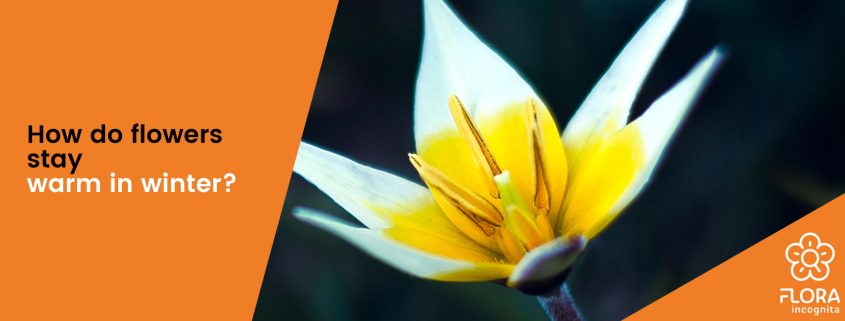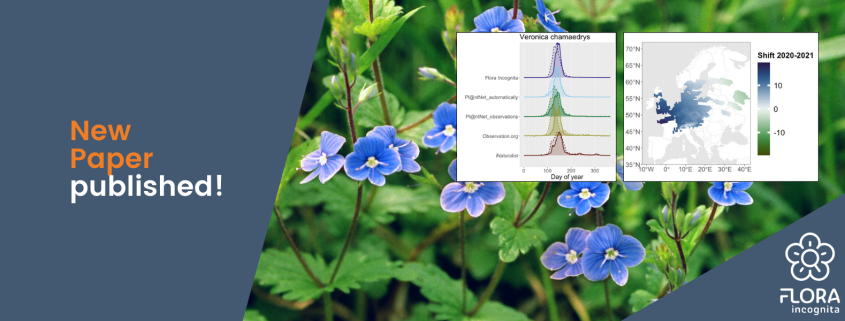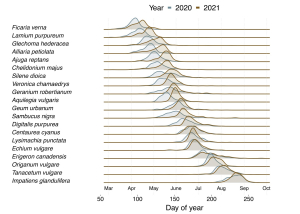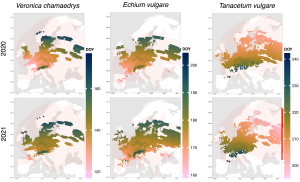A closer look at flowers: thermoregulation in winter
In winter or in cold habitats such as high mountains, an optimal flower temperature is important for successful reproduction. Some plants can actively produce heat in their flowers, such as Helleborus foetidus, using yeast bacteria in the nectar (Herrera and Pozo, 2010). But this is the exception. For most plants in cold regions (or early bloomers), the more heat they can absorb from the environment, or at least not lose, the better. In this story you will learn what influence characteristics such as shape, colour, pubescence or orientation to the sun have on the temperature in the flower.
Bells and discs
Have you ever wondered why many early bloomers have bell-shaped flowers? The answer is that bells collect more heat than disc-shaped flowers. Hanging bells can absorb heat from the ground radiation and so the temperature inside the flower lies 3-11 °C above the ambient temperature (Kevan, 1989). Upright bells, such as gentians, bundle the sun’s rays when they fall at a certain angle. In disc-shaped flowers, the reproductive organs are directly exposed to the environment and are located in the centre, where most of the incoming light is reflected by the flower. But the petals also play a role. In one experiment, the excess temperature in Saxifraga oppositifolia flowers was reduced by 70% compared to the surrounding area after removing the petals (Kevan, 1970).
Micro-greenhouses
Another successful strategy is the formation of “micro-greenhouses”. These are, for example, bubble-shaped structures made of translucent bracts, as in the yellow rattle (Rhinanthus minor), or sepals, as in Physalis. These filter light in the UV range, but allow longer wavelengths to pass through, which heats the air inside. Similar to flowers, hollow stems can also have a heating effect if the heat trapped in the stem leads to an increase in internal temperature (Kevan et al. 2018, 2019). This can promote the development of the flower bud immediately above it.
Orientation towards the sun (heliotropism)
During the course of the day, some plants permanently orientate their flowers so that they face the sun. In cold regions in particular, this leads to effective warming of the flower. This can have advantages for the plant, for example through increased temperatures in the reproductive organs, heavier seeds and more visits from pollinators. Many experiments have already tried to demonstrate the added value of heliotropism, but not always successfully. (Van der Kooi, 2019).
Colour
Darker colours can absorb more solar radiation. This can be converted into heat, which can increase the temperature of the flower. In a series of experiments with Plantago, a close relationship was found between the colour of the flower-bearing inflorescence and its temperature. Individuals developing at low temperatures produced darker panicles that were 0.2-2.6 °C warmer in direct sunlight than the comparison group (Anderson et al., 2013). Another study found that purple-coloured flowers of Ranunculus glacialis were warmer and produced more seeds than white-coloured flowers of the same species (Ida & Totland, 2014). However, there are also studies in which the colour of the flower has no influence on the flower temperature (Van der Kooi, 2019). Further studies are needed to better understand the relationship between flower colour, temperature and reproductive capacity.
Opening and closing
The opening and closing of flowers through petal movement is widespread throughout the plant world. In particular, cup- or disc-shaped flowering species protect themselves from external factors such as light, moisture or temperature in this way. Opening and closing can take several minutes or hours, depending on the species. It is assumed that closing the flower protects the pollen from precipitation (washing out, damage) or drying out, which increases its viability. There are various experiments that have investigated the influence of flower closure on the temperature inside the flower: For example, if the bracts of Tulipa iliensis close at cool temperatures, a more constant temperature is maintained inside the flower (Abdusalam and Tan, 2014).
Hairs
The pubescence of flowers is probably important for maintaining flower temperature, but in contrast to leaf pubescence, this has been little studied to date. Plant species that grow in high-altitude, cold regions sometimes develop thick leaf pubescence. This creates an insulating boundary layer to the neighbouring cold air mass, which reduces heat loss (Meinzer and Goldstein, 1985). The pubescence of the flowers can have a similar insulating effect as in the example of willow catkins: In Alaska, it was investigated that it can be 15-25 °C inside willow catkins at an air temperature of 0 °C. If the woolly hairs were removed, the internal temperatures in the catkins fell by around 60% (Krog, 1955).
References:
• Herrera CM, Pozo MI. 2010. Nectar yeasts warm the flowers of a winter-blooming plant. Proceedings of the Royal Society of London B 277: 1827–1834.
• Kevan PG. 1989. Thermoregulation in arctic insects and flowers: adaptation and co-adaptation in behaviour, anatomy, and physiology. Thermal Physiology 1: 747–753.
• Kevan PG, Nunes-Silva P, Sudarsan R. 2018. Short communication: thermal regimes in hollow stems of herbaceous plants—concepts and models. International Journal of Biometeorology 62: 2057–2062.
• Kevan PG, Tikhmenev EA, Nunes-Silva P. 2019. Temperatures within flowers and stems: possible roles in plant reproduction in the north. Bulletin of the NorthEastern Science Centre of the Russian Academy of Sciences, Magadan, Russia 1: 38–47.
• Casper J van der Kooi, Peter G Kevan, Matthew H Koski, The thermal ecology of flowers, Annals of Botany, Volume 124, Issue 3, 16 August 2019, Pages 343–353,
• Anderson ER, Lovin ME, Richter SJ, Lacey EP. 2013. Multiple Plantago species (Plantaginaceae) modify floral reflectance and color in response to thermal change. American Journal of Botany 100: 2485–2493.
• Ida TY, Totland Ø. 2014. Heating effect by perianth retention on developing achenes and implications for seed production in the alpine herb Ranunculus glacialis. Alpine Botany 124: 37–47.
• Abdusalam A, Tan D-Y. 2014. Contribution of temporal floral closure to reproductive success of the spring-flowering Tulipa iliensis. Journal of Systematics and Evolution 52: 186–194.
• Meinzer F, Goldstein G. 1985. Some consequences of leaf pubescence in the Andean giant rosette plant Espeletia timotensis. Ecology 66: 512–520.
• Krog J. 1955. Notes on temperature measurements indicative of special organization in arctic and subarctic plants for utilization of radiated heat from the sun. Physiologia Plantarum 8: 836–839.
• Kevan PG. 1970. High arctic insect-flower relations: the inter-relationships of arthropods and flowers at Lake Hazen, Ellesmere Island, N.W.T., Canada. PhD Thesis, University of Alberta, Canada.
This article was featured as a story in the Flora-Incognita app in winter 2024. In this plant identification app, you can find exciting information about plants, ecology, and species knowledge, as well as tips and tricks for plant identification. Check it out!




